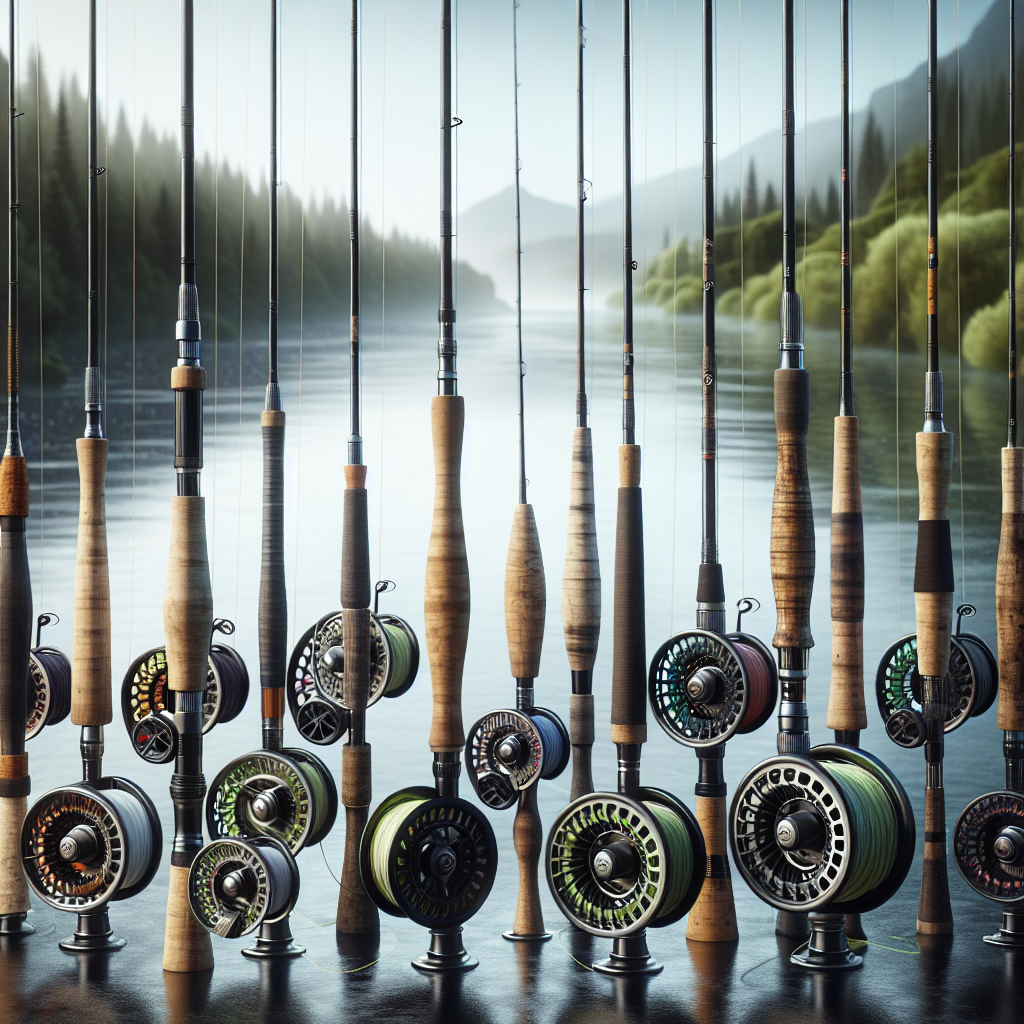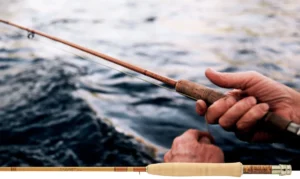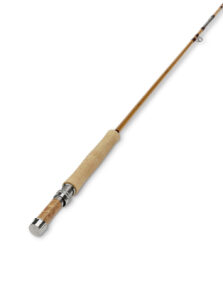
“Wolton Pawell Bamboo Flyfishing Rod …” from www.flickr.com and used with no modifications.
Unlocking the Value of Vintage Bamboo Rods
When it comes to fly fishing, the rod you hold is more than just a tool; it’s a bridge to the past. Bamboo fly rods, with their rich history and exquisite craftsmanship, are treasures that can hold significant value. Whether you’ve inherited a rod, stumbled upon one at a garage sale, or are a seasoned collector, understanding the worth of these vintage pieces is both exciting and essential.
Article-At-A-Glance
-
Bamboo fly rods can be valuable collectibles, with worth influenced by their condition, rarity, and maker.
-
Names like Orvis, Hardy, and Garrison carry weight in the bamboo rod world, often indicating higher value.
-
Assessing a rod’s value involves examining its condition, verifying its age, and understanding market demand.
-
The history and craftsmanship of bamboo rods elevate them beyond mere fishing tools to pieces of angling art.
-
Preserving the originality and integrity of a bamboo rod is crucial in maintaining its value over time.
What Makes Bamboo Rods Special?
There’s a whisper of history in every bamboo fly rod, a story of riverside adventures and the hands that crafted them. These rods are special not just for their age but for the meticulous process that went into making each one. Unlike modern materials, bamboo requires a level of craftsmanship that can’t be replicated by machines. The natural material provides a unique flexibility and strength, creating a fishing experience that’s as smooth as it is nostalgic.
-
Handcrafted artistry that stands the test of time.
-
Natural bamboo offers a unique feel and responsiveness.
-
Each rod tells a story, connecting anglers to the tradition of fly fishing.
-
Collectible value that may appreciate over the years.
-
Environmental sustainability of using natural materials.
These rods aren’t just tools; they’re a piece of history, a connection to a simpler time when the rhythm of casting a line was the day’s main event. They remind us that fly fishing is not just about the catch, but about the dance between angler and stream.
Famous Makers and Price-Influencing Names
Just like artists sign their paintings, the makers of bamboo rods often left their mark, literally. Names such as Orvis, Hardy, and Garrison are the Rembrandts of the rod world, and finding one of these signatures can mean you’re holding a small fortune. These makers are known for their dedication to quality and their pioneering contributions to the sport of fly fishing.
-
Orvis – A name synonymous with fly fishing excellence.
-
Hardy – British craftsmanship that set the standard worldwide.
-
Garrison – American-made rods with a reputation for precision.
-
Leonard – Innovative designs that revolutionized rod making.
-
Payne – Refined rods that are as beautiful as they are functional.
Remember, the value of a rod can skyrocket if it’s tied to one of these legendary names. But it’s not just about the label; it’s the story behind it, the hands that shaped the bamboo, and the waters it’s graced that build its legacy.
How to Gauge Your Bamboo Fly Rod’s Value
Figuring out what your bamboo fly rod is worth isn’t just a matter of looking it up in a book. It’s about understanding its story, its condition, and the current market. You’ll want to start by getting to know your rod, examining it carefully for any identifying marks or signatures. Then, consider its condition – is it as sturdy as the day it was made, or showing signs of a well-loved life?
Next, delve into its past. How old is your rod? Was it a limited edition or mass-produced? These details can make a big difference in its value. And don’t forget to keep an eye on the market. What are collectors looking for? What have similar rods sold for recently? This information will give you a clearer picture of your rod’s potential worth.
But remember, value isn’t just about dollars and cents. It’s about the joy of casting a line with a piece of history, the thrill of the hunt for that elusive signature, and the pride of preserving a piece of fly fishing heritage. Whether you’re looking to sell or simply understand what you have, knowing the value of your bamboo fly rod is a journey worth taking.
Identifying the Rod’s Age and History
Unlocking the age and history of your bamboo fly rod is like piecing together a puzzle from the past. Start by searching for any markings or engravings on the rod that could indicate the maker or production date. These clues are often found near the handle or along the rod’s shaft. A rod’s age can be a significant factor in its value – the older, the better, as long as it’s in good condition. Historical significance, such as a rod made for a notable event or owned by a famous angler, can also boost its worth.
-
Look for maker’s marks, serial numbers, or dates on the rod.
-
Research the manufacturer to determine the rod’s era.
-
Check old catalogs or fishing magazines for model identification.
-
Seek out expert opinions or join collector forums for insights.
-
Trace the rod’s ownership history if possible.
Knowing the rod’s backstory can transform it from a simple tool to a cherished heirloom with a tale to tell. It’s these stories that often captivate collectors and can turn your rod into a sought-after piece of angling history.
Determining the Condition of Your Rod
The condition of your bamboo fly rod is critical in assessing its value. Inspect it carefully from end to end. Check for any signs of damage, such as cracks, splits, or warping, which can diminish its worth. Original components like the reel seat, guides, and finish all play a part in the rod’s overall condition. A rod that’s in pristine shape, or even better, unused, can fetch top dollar in the collector’s market.
-
Examine the rod for structural integrity – look for cracks or breaks.
-
Ensure all parts are original and intact.
-
Check the finish for wear or discoloration.
-
Assess the wrapping and guides for any repairs or replacements.
-
Look for signs of excessive use or poor storage conditions.
A well-maintained rod that’s stood the test of time not only reflects its durability but also the care it’s received from previous owners, adding to its narrative and appeal.
Recognizing Rarity and Exclusive Features
Rarity can turn an old bamboo rod into a prized possession. Limited production runs, custom designs, or rods from a renowned maker’s golden era can all increase rarity. Exclusive features such as intricate engravings, signature wraps, or unusual hardware set a rod apart from the rest. These unique characteristics often catch the eye of collectors who are willing to pay a premium for something truly special.
-
Identify any unique design elements or craftsmanship.
-
Research production numbers – fewer rods mean higher rarity.
-
Look for special editions or rods associated with significant events.
-
Consider the story behind the rod – was it custom-made for someone notable?
-
Take note of any bespoke features that deviate from standard models.
A bamboo rod with a story or distinctive feature that sets it apart from others is more than just a fishing tool; it’s a piece of art that tells a story, and that’s something collectors are always on the hunt for.
The Market’s Demand: What Collectors Look For
The collector’s market for bamboo fly rods is both niche and knowledgeable. Enthusiasts are always on the lookout for rods that have a certain ‘je ne sais quoi’ – whether it’s the pedigree of the maker, the era of production, or the rarity of the model. They seek rods that have been well-preserved, preferably in their original state, and those that have a rich history or provenance.
Understanding Collectors’ Desires
Collectors often have a wishlist of specific rods they’re after, and they’re willing to go to great lengths to acquire them. They desire rods that have a story, such as those owned by famous anglers or used in significant tournaments. The allure of a rod can also be enhanced by its previous owners, especially if they were well-known in the angling community. Additionally, collectors look for rods that have been kept in excellent condition, as these are more likely to retain or increase in value over time.
-
Authenticity is key – original condition rods are highly sought after.
-
Provenance can significantly add to a rod’s desirability and value.
-
Condition is paramount – collectors prefer rods without repairs or alterations.
-
Historical significance of the rod or its maker can pique interest.
-
Unique attributes or limited edition models are in high demand.
Understanding what makes a bamboo fly rod desirable to collectors is essential whether you’re looking to buy, sell, or simply appreciate the value of what you already own. It’s the combination of history, craftsmanship, condition, and rarity that ultimately determines a rod’s place in the market and in the hearts of collectors.
Price Trends and Auction Records
Keeping an eye on the ebb and flow of the market is crucial when it comes to bamboo fly rods. Auction records can be telling of what’s hot and what’s not. In recent years, we’ve seen a steady interest in high-quality vintage rods, with prices reflecting the meticulous craftsmanship of yesteryears. Auctions are where the magic happens, and a rod that might seem ordinary can fetch an extraordinary price if two collectors set their hearts on it.
-
Watch for auction results to stay informed on current pricing trends.
-
High-quality rods from notable makers consistently perform well.
-
Prices can surge when there’s a backstory or a celebrity connection.
-
Keep records of sales for similar rods to gauge your own rod’s potential value.
-
Online auction platforms can provide a wealth of historical price data.
Remember, an auction is a snapshot of what one person is willing to pay at a particular moment in time. It’s the dance of supply and demand right before your eyes, and it can give you a good idea of what your bamboo treasure might be worth.
Caring for Your Bamboo Fly Rod
Like any valuable collectible, a bamboo fly rod requires care and attention to maintain its worth. These rods are not just fishing tools; they are pieces of history that demand respect. Proper care ensures that your rod will continue to provide both fishing pleasure and financial value for years to come.
Preservation Tips to Maintain Value
Preserving a bamboo fly rod is all about protecting its integrity. Store your rod in a cool, dry place away from direct sunlight to prevent warping and fading. Use a rod tube and a cloth bag to shield it from dust and damage. Never store the rod assembled; instead, take it apart to relieve tension on the ferrules and to avoid setting a curve.
-
Avoid extreme temperatures and humidity that can damage the bamboo.
-
Clean your rod gently after use, especially before long-term storage.
-
Regularly inspect for signs of wear or damage and address them promptly.
-
Use a soft, dry cloth for cleaning and avoid harsh chemicals.
-
Apply a light coat of wax to protect the finish and enhance the shine.
By following these simple steps, you’re not just caring for a rod; you’re safeguarding a legacy that can be passed down through generations.
Do’s and Don’ts of Restoration
Restoration can be a double-edged sword. On one hand, it can bring a rod back to its former glory. On the other, it can reduce its value if not done correctly. If you decide to restore your rod, do so with the utmost care and preferably by a professional who specializes in bamboo rods. Keep any replaced parts, as they can add to the rod’s story and authenticity.
-
Do consult with experts before undertaking any restoration work.
-
Don’t use modern varnishes or glues that can detract from the rod’s originality.
-
Do match any new wraps or guides to the original as closely as possible.
-
Don’t sand down the bamboo; it can ruin the rod’s integrity and value.
-
Do document any restoration work, as provenance is vital for collectors.
Restoration should be about preserving the past, not rewriting it. Approach any changes with reverence for the rod’s original state and the story it tells.
When to Sell and Where
Deciding to part with a bamboo fly rod is as much an emotional decision as it is financial. Timing can be everything in getting the best price for your rod. Keep an eye on market trends and consider selling when demand is high and supply is low. Spring, just before fishing season kicks off, can be a prime time as anglers look to add to their collections.
Choosing the Right Time to Sell Your Rod
When you’re ready to sell, think about the timing. Is there a buzz in the collector’s community? Are certain makers or models gaining attention? Aligning your sale with these trends can mean a significant difference in the final price. Also, consider personal timing – are you ready to let go, or does the rod still bring you joy? It’s a balance between emotional attachment and practical considerations.
-
Monitor collector forums and auction sites for the best selling times.
-
Align your sale with fishing seasons and collector interest peaks.
-
Assess your personal connection to the rod before deciding to sell.
-
Keep an eye on the economic climate, as it can influence discretionary spending.
Choosing the right moment to sell can be the difference between a good deal and a great one.
Selecting the Best Platforms for Sale
Where you sell your rod can be as important as when you sell it. Online auction sites like eBay can reach a wide audience, but specialized fishing forums or collector groups might connect you with more serious buyers. Consignment through a reputable dealer or an auction house that specializes in fishing gear can also be a good route, especially for high-end rods.
-
Consider online auction sites for a broad reach.
-
Look into specialized fishing forums for knowledgeable buyers.
-
Utilize consignment shops or auction houses with a focus on fishing gear.
-
Attend fishing shows or flea markets where collectors might congregate.
-
Use social media to tap into fly fishing communities and networks.
Choose a platform that aligns with your goals, whether that’s a quick sale or getting the best possible price for your bamboo fly rod.
Choosing the Right Time to Sell Your Rod
Timing is everything, and in the world of vintage bamboo fly rods, this couldn’t be more true. To maximize your rod’s value, it’s crucial to keep a pulse on the market’s heartbeat. Spring often sees a surge in interest as anglers gear up for the season. Conversely, selling during the off-season might mean your rod gets overlooked. Watch for trends, such as a resurgence in popularity of certain brands or styles, which can signal a prime selling opportunity.
-
Track the seasons – spring and early summer can be peak times for selling.
-
Stay informed about trends in vintage rod collecting.
-
Consider economic factors that might affect buyers’ spending habits.
-
Watch for notable auctions that might increase interest in similar rods.
-
Listen to the buzz within the fly fishing community for optimal timing.
Remember, selling your bamboo rod isn’t just about the right time; it’s also about the right reason. If the rod still brings you joy or holds sentimental value, it might be worth holding onto it a little longer.
Selecting the Best Platforms for Sale
Where you sell your bamboo fly rod can significantly impact the success of the transaction. Online platforms offer convenience and a broad audience, but niche communities appreciate the subtleties of a fine vintage rod. Consider platforms like eBay for exposure or reach out to specialized fly fishing forums where enthusiasts gather. For a more curated approach, high-end auction houses or consignment with a reputable dealer can attract serious collectors willing to pay for quality and history.
-
eBay and other online marketplaces for broad exposure.
-
Specialized forums and groups for targeted audiences.
-
Auction houses for curated, competitive selling environments.
-
Local antique shops or flea markets for a personal touch.
-
Social media platforms to leverage personal networks and fly fishing communities.
Choose a platform that not only reaches the right buyers but also feels right for you. It’s about connecting your rod with someone who will value its history as much as you do.
Final Reflections on Bamboo Rods’ Worth
As we’ve explored, the worth of a bamboo fly rod is multifaceted. It’s not just about the monetary value but also the stories these rods carry and the craftsmanship they showcase. They are relics of a bygone era, pieces of angling history that continue to inspire and captivate. Whether you’re a collector, an angler, or someone who appreciates fine craftsmanship, bamboo rods hold a special place in the world of fly fishing.
Ultimately, the worth of your bamboo rod is what it means to you. It might be a financial investment, a treasured family heirloom, or a reminder of your connection to nature and the timeless art of fly fishing. Whatever value you place on your bamboo rod, cherish it for the joy it brings, both on and off the water.
Frequently Asked Questions (FAQ)
How do I know if my bamboo fly rod is an antique?
Identifying an antique bamboo fly rod involves a bit of detective work. Look for maker’s marks, which are often found on the butt cap or near the handle. Research the manufacturer’s history to determine when your rod might have been made. Rods that are 100 years old or more are typically considered antiques. Also, consult vintage fishing equipment catalogs, connect with experts, and join collector forums for insights. The materials, construction techniques, and design can also provide clues to its age.
-
Search for maker’s marks or signatures on the rod.
-
Research the manufacturer’s history and rod models.
-
Consult vintage fishing catalogs for similar rods.
-
Seek expertise from antique fishing gear collectors.
-
Examine the rod’s materials and construction for age indicators.
Remember, an antique rod is not just defined by its age but also by the stories it tells and the craftsmanship it represents. Whether you’re confirming its status as an antique or simply appreciating its place in history, your bamboo rod is a link to the rich tradition of fly fishing.
Can restoring my bamboo rod increase its value?
Restoration can be a delicate balance. If done correctly, it can breathe new life into a bamboo rod, enhancing its appeal and potentially its value. However, it’s essential to restore with reverence for the rod’s original state. Over-restoration or using non-period-correct materials can actually detract from its value. Collectors often prize originality over a rod that looks new but lacks historical authenticity. If you’re considering restoration, consult with a professional who specializes in vintage bamboo rods and always keep the rod’s original parts and finish in mind.
-
Restoration should be minimal and preserve original features.
-
Use period-correct materials and techniques.
-
Professional restoration can be a good investment.
-
Over-restoration can reduce a rod’s value.
-
Document the restoration process for future reference.
Ultimately, the goal of restoration should be to honor the rod’s history, not erase it. A well-restored rod that maintains its character can be a more attractive piece to both collectors and those looking to fish with a piece of history.
Why are shorter bamboo rods usually more valuable?
Shorter bamboo rods often carry a higher value for a few reasons. Firstly, they’re less common. Many bamboo rods were made in longer lengths for a variety of fishing conditions, making the shorter rods rarer and more collectible. Secondly, shorter rods require a higher level of craftsmanship to maintain the same level of performance and balance as their longer counterparts. This craftsmanship can make them more desirable to collectors and anglers alike. Lastly, shorter rods are often more versatile and sought after by fly fishers who fish in smaller streams, adding to their practical value.
-
Rarity due to fewer shorter rods being produced.
-
Increased craftsmanship required for shorter rod production.
-
Desirability for fishing in smaller, more challenging streams.
-
More convenient for transport and storage.
So, if you’re lucky enough to own a shorter bamboo rod, take good care of it. Its value may well be greater than you realize, both for its fishing capabilities and its worth to collectors.
What are some of the top brands that signify a valuable fly rod?
Several brands are renowned for producing bamboo fly rods that are highly valued by collectors and anglers. These include Orvis, Hardy, Leonard, Payne, and Garrison. Each of these brands has a storied history in rod making, and their rods are known for their quality, performance, and beauty. Rods from these makers, especially those in original condition or with a unique history, are often sought after in the collector’s market and can command high prices.
-
Orvis – Known for their innovation and enduring quality.
-
Hardy – A British brand with a legacy of craftsmanship.
-
Leonard – Pioneers in bamboo rod making with a focus on precision.
-
Payne – Renowned for their elegant designs and superior performance.
-
Garrison – American rods celebrated for their balance and finesse.
These brands represent the pinnacle of bamboo rod making and owning one of their rods is not just a privilege, it’s an investment in fly fishing history.
How do I find out what my vintage bamboo rod is worth?
To determine the value of your vintage bamboo rod, start by identifying its make, model, and condition. Research the brand and consult vintage fishing equipment catalogs or collector’s books. Online forums and communities can also be a wealth of information, as can professional appraisers who specialize in vintage fishing gear. Consider recent auction results for similar rods to gauge the market value. Remember, factors like rarity, condition, and provenance will all play a role in determining its worth.
-
Identify the rod’s make, model, and condition.
-
Research using catalogs, books, and online resources.
-
Consult with professional appraisers or collectors.
-
Compare with recent sales of similar rods.
-
Consider the rod’s history and any unique features.
Knowing the value of your bamboo rod can be a rewarding process, offering insight into its place in the rich tapestry of fly fishing history and its potential as a financial investment.
In conclusion, the world of vintage bamboo fly rods is filled with stories, craftsmanship, and a deep sense of tradition. Whether you’re a seasoned collector, an angler with a passion for history, or someone who’s just inherited a mysterious bamboo rod, understanding its value is a journey through the heart of fly fishing. These rods are more than just tools; they are legacies of a sport that continues to captivate and inspire. They remind us of the rivers they’ve graced, the hands that have crafted them, and the timeless dance between angler and stream. So, cherish your bamboo fly rod, for it holds stories of the past and promises adventures yet to come.





